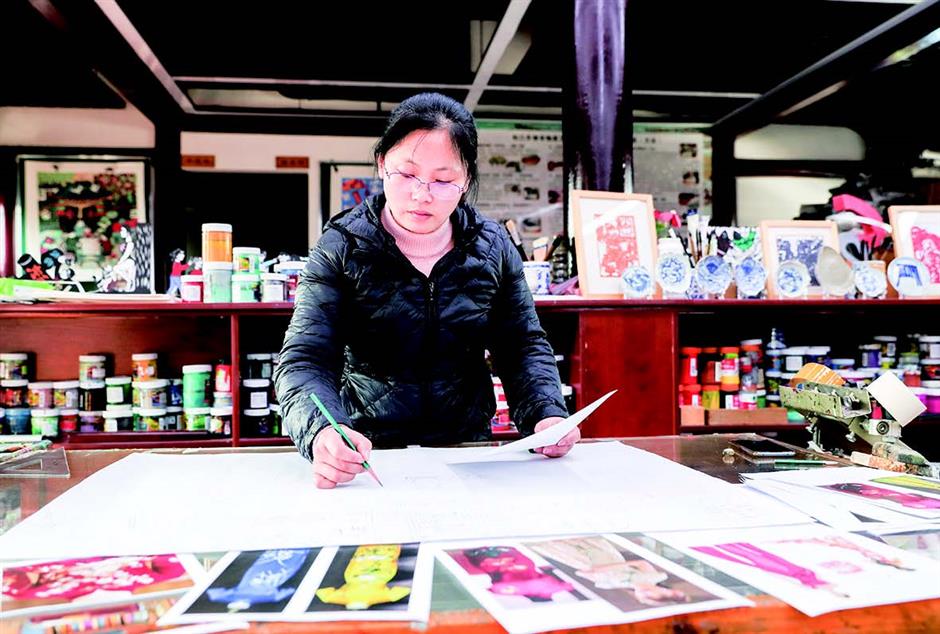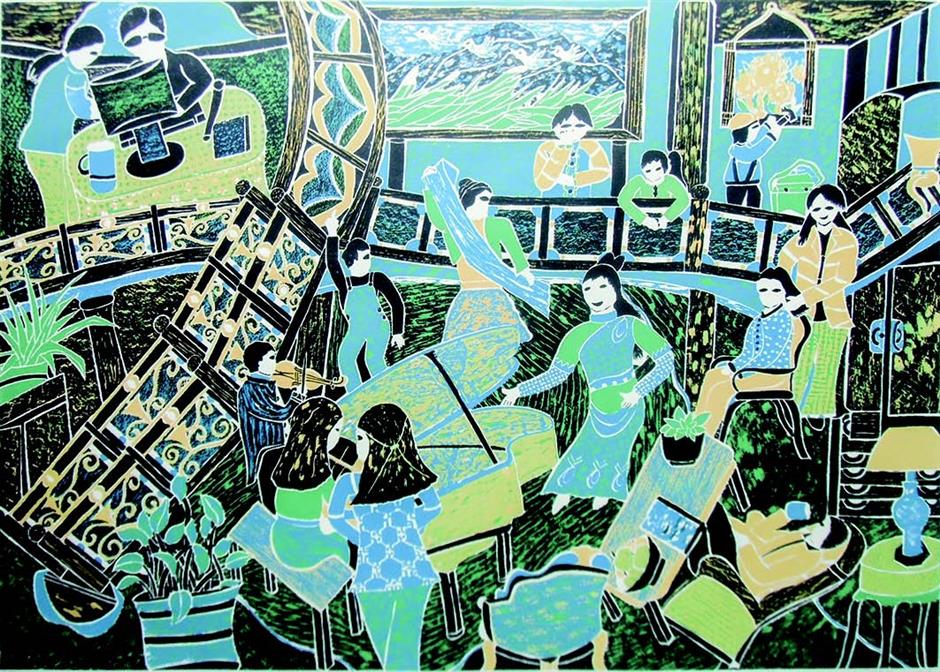Country artist Hu Jinzhen uses simple techniques to portray her pastoral life.

Rural artist Hu Jinzhen at work in the studio.
Rural artist Hu Jinzhen uses brush and paint, paper cuts and block printing to create idyllic pastoral images that portray her own "Garden of Eden."
The 45-year-old farmer from Chedun Town, Songjiang District, was happily surprised to have had her her silkscreen block print painting "Happy Family" chosen for display in the National Farmers' Painting Exhibition.
The artwork features clean greens and blues against a black background, with its straight lines showing a strong folk vitality with a rustic, primitive ambience. Hu has not portrayed her characters' facial expressions in detail, but viewers can feel the happiness inherent in their faces from her simple, forceful strokes.
"I like to paint families and my fellow countryfolk," Hu said. "They are where I gain my strength and support."
Family is a constant theme for village dweller Hu. Her brother and sister-in-law are disabled and her niece is on the autism spectrum. Hu works from 9am to 5pm as a volunteer in Chedun's Home for the Handicapped, and returns home after work to care for her family.
"I'm lucky that my husband supports me greatly," she said.

"Countryside Scenery in Huayang" by Hu Jinzhen

"Happy Family" by Hu Jinzhen
Painting is a respite for Hu from her challenging daily routine and offers her peaceful moments that belong solely to her.
Her art is carefree and portrays her simple life in the village. She depicts peaceful-flowing rivers with their waters swept by gentle breezes, small village lanes flanked by old brick houses, and merry groups of countryfolk sitting together, mingling and chatting.
A local farmer, Hu had never picked up a paint brush until 10 years ago, when a free five-day course was offered by the town's Silkscreen Block Print Painting Society at the Home for the Handicapped. The art form intrigued Hu, and she felt her creativity growing.
After the short course ended, Hu continued studying at the society every weekend.
"It requires time and relentless practice. I take art very seriously," she said.
Silkscreen block printing is a folk art that has long been popular in Chedun. In the 1980s, the local government launched a program to teach the techniques to farmers to carry on the tradition and to provide a stimulating hobby for farmers during their slack seasons.
The art form requires an ability to paint as well as the skill to master printing techniques to work with the necessary machines and tools.
One of the more common methods of creating a silk-screen stencil is through making a negative image. The image is printed on a transparent sheet and placed on wet emulsion so only the uncovered emulsion dries, creating the stencil. Each color requires an individual silkscreen block, so if a painting contains five colors, it needs five printing blocks.
Farmer painters are considered to be in the "primitive camp" of artists, and mainly use striking colors and simple themes. Rather than exploring modern urban reality, traditional rural themes such as fishing, cloth dyeing, spinning and market scenes are common. Figures and objects are drawn in a way that some viewers may consider childish, with thick straight lines, yet producing a strong visual effect.

"Car Check," a paper-cut artwork by Hu Jinzhen.
Hu recalls her first work, which took her two months to finish. "I drew a lotus pond and small bridges, based on a family trip with my children," she said.
Progressing from a novice to become a member of the Shanghai Artists Association, Hu has put great effort into her art, but also achieved much from it. She said painting is her time out, a haven and a warm harbor in which to anchor.
Silkscreen block printing particularly charms her because of its infinite possibilities using finite colors. For example, her artwork "Countryside Scenery in Huayang" depict gently-propelled wooden boats, villagers strolling in along riverside alleyways and children leaning over the sides of a bridge.
At first glance it appears multi-hued, but a closer look shows it only contains four separate colors.
Because each color requires one silkscreen block, the painting required four blocks and four printings to achieve the final artwork.
"You never know what the final result will be until the last moment," Hu said. "It gives me a great sense of success to see that each of my intentions is fulfilled in each step."
















